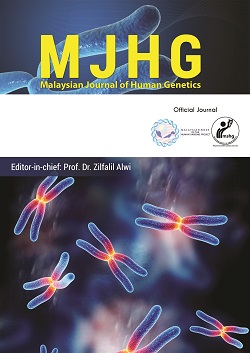An overview of the genetic variations associated with the pathophysiology and mechanisms of sudden cardiac death
Keywords:
Sudden Cardiac Death, KCNQ1, SCN5A, Long QT syndrome, Cardiac geneticAbstract
Sudden cardiac death (SCD) is one of the commonest causes of death among young adults. Cardiac arrhythmias secondary to channelopathies are one of the main causes of SCD. Channelopathies is a condition where there are abnormalities of one or more ion channels involved in the cardiac action potential. These ion channels are strictly regulated and encoded by a specific gene for each channel. As for current knowledge, KCNQ1, SCN5A, CACN1AC, CALM1, and RYR2 are the most studied genetic mutation in inherited sudden cardiac death patient. There are five most common chromosomes involved in this condition namely chromosome 1q42 to q43, 3p21, 7,11, and 12 which encodes RYR2, SCN5A, KCNH, KCNQ1 and CACN1AC respectively. Two most common types of genetic mutation involved are loss-of -function mutation and missense mutations. Any disturbance in channel morphology or function due to genetic mutation will lead to channelopathies for example SCN5A gene gain function mutation in Long QT syndrome. This condition is an inherited disorder and mainly inherited by autosomal dominant. Therefore, genetic linkage study by cascade family screening is important for the early detection of this condition and to reduce the risk of sudden cardiac death among young patients.
Downloads
References
Alders, Mariëlle, Hennie Bikker, and Imke Christiaans. 2003. Long QT Syndrome. https://www.ncbi.nlm.nih.gov/books/.
Baltogiannis GG, Lysitsas DN, di Giovanni G, Ciconte G, Sieira J, Conte G, Kolettis TM, Chierchia GB, de Asmundis C, Brugada P. CPVT: Arrhythmogenesis, Therapeutic Management, and Future Perspectives. A Brief Review of the Literature. Front Cardiovasc Med. 2019 Jul 12;6:92.
Brugada R, Campuzano O, Sarquella-Brugada G, Brugada J, Brugada P. Brugada syndrome. Methodist Debakey Cardiovasc J. 2014 Jan-Mar;10(1):25-8.
Cerrone, Marina, Samori Cummings, Tarek Alansari, and Silvia G. Priori. 2012. “A Clinical Approach to Inherited Arrhythmias.” Circulation: Cardiovascular Genetics 5(5): 581–90.
DeMarco, K. R., and C. E. Clancy. 2016. “Cardiac Na Channels: Structure to Function.” Current Topics in Membranes 78: 287–311.
Gardner, R. J.Mc Kinlay et al. 2019. “Penetrance and Expressivity of the R858H CACNA1C Variant in a Five-Generation Pedigree Segregating an Arrhythmogenic Channelopathy.” Molecular Genetics and Genomic Medicine 7(1).
Grant, Augustus O. 2009. “Cardiac Ion Channels.” Circulation: Arrhythmia and Electrophysiology 2(2): 185–94.
Gray, Belinda, and Elijah R. Behr. 2016. “New Insights into the Genetic Basis of Inherited Arrhythmia Syndromes.” Circulation: Cardiovascular Genetics 9(6): 569–77.
Hayashi, Meiso, Wataru Shimizu, and Christine M. Albert. 2015. “The Spectrum of Epidemiology Underlying Sudden Cardiac Death.” Circulation Research 116(12): 1887–1906.
Isbister, Julia, and Christopher Semsarian. 2019. “Sudden Cardiac Death: An Update.” Internal Medicine Journal 49(7): 826–33.
Laitinen, Päivi J et al. 2001. Mutations of the Cardiac Ryanodine Receptor (RyR2) Gene in Familial Polymorphic Ventricular Tachycardia. http://www.ncbi.n-.
Li, Guoliang, and Li Zhang. 2018. “The Role of Mexiletine in the Management of Long QT Syndrome.” Journal of Electrocardiology 51(6): 1061–65.
Li, Na et al. 2017. “Treatment of Catecholaminergic Polymorphic Ventricular Tachycardia in Mice Using Novel RyR2-Modifying Drugs.” International Journal of Cardiology 227: 668–73.
Li, Wenjia et al. 2018. “SCN5A Variants: Association with Cardiac Disorders.” Frontiers in Physiology 9(OCT).
Makita, Naomasa et al. 2014. “Novel Calmodulin Mutations Associated with Congenital Arrhythmia Susceptibility.” Circulation: Cardiovascular Genetics 7(4): 466–74.
Dhar Malhotra J, Chen C, Rivolta I, Abriel H, Malhotra R, Mattei LN, Brosius FC, Kass RS, Isom LL. Characterization of sodium channel alpha- and beta-subunits in rat and mouse cardiac myocytes. Circulation. 2001 Mar 6;103(9):1303-10.Masrur, Shihab, Sarfaraz Memon, and Paul D. Thompson. 2015. “Brugada Syndrome, Exercise, and Exercise Testing.” Clinical Cardiology 38(5): 323–26.
Di Mauro V, Ceriotti P, Lodola F, Salvarani N, Modica J, Bang ML, Mazzanti A, Napolitano C, Priori SG, Catalucci D. Peptide-Based Targeting of the L-Type Calcium Channel Corrects the Loss-of-Function Phenotype of Two Novel Mutations of the CACNA1 Gene Associated With Brugada Syndrome. Front Physiol. 2021 Jan 8;11:616819.
Mesirca, Pietro, Angelo G. Torrente, and Matteo E. Mangoni. 2015. “Functional Role of Voltage Gated Ca2+ Channels in Heart Automaticity.” Frontiers in Physiology 6(FEB): 19.
Napolitano C, Priori SG, Bloise R. Catecholaminergic Polymorphic Ventricular Tachycardia. 2004 Oct 14 [Updated 2016 Oct 13]. In: Adam MP, Mirzaa GM, Pagon RA, et al., editors. GeneReviews® [Internet]. Seattle (WA): University of Washington, Seattle; 1993-2022. Available from: https://www.ncbi.nlm.nih.gov/books/NBK1289/Paavola, Jere et al. 2007. “Mutant Ryanodine Receptors in Catecholaminergic Polymorphic Ventricular Tachycardia Generate Delayed Afterdepolarizations Due to Increased Propensity to Ca2+ Waves.” European Heart Journal 28(9): 1135–42.
Priori, Silvia G. et al. 2015. “2015 ESC Guidelines for the Management of Patients with Ventricular Arrhythmias and the Prevention of Sudden Cardiac Death the Task Force for the Management of Patients with Ventricular Arrhythmias and the Prevention of Sudden Cardiac Death of the European Society of Cardiology (ESC) Endorsed by: Association for European Paediatric and Congenital Cardiology (AEPC).” European Heart Journal 36(41): 2793–2867l.
Roh, Seung Young et al. 2020. “Incidence and Etiology of Sudden Cardiac Arrest in Koreans: A Cohort from the National Health Insurance Service Database.” PLoS ONE 15(11 November).
Sumitomo, Naokata. 2016. “Current Topics in Catecholaminergic Polymorphic Ventricular Tachycardia.” Journal of Arrhythmia 32(5): 344–51.
Watanabe, Atsuyuki et al. 2005a. “Long QT Syndrome.” Nippon rinsho. Japanese journal of clinical medicine 63(7): 1171–77.
Wong, Christopher X. et al. 2019. “Epidemiology of Sudden Cardiac Death: Global and Regional Perspectives.” Heart Lung and Circulation 28(1): 6–14.
Zipes DP, Wellens HJ. Sudden cardiac death. Circulation. 1998 Nov 24;98(21):2334-51.
Downloads
Published
Issue
Section
License
Copyright (c) 2024 Malaysian Journal of Human Genetics

This work is licensed under a Creative Commons Attribution 4.0 International License.


